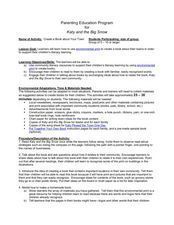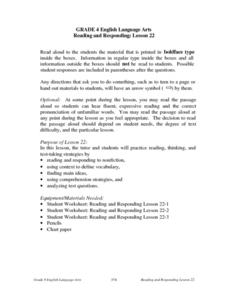Curated OER
Halloween Poem And Story Book Covers And Writing Paper
In this Halloween writing worksheet, students use the cover sheet and decorated lined paper to write poems and stories of their own. Students may staple the pages into a book.
Curated OER
Something's Fishy
Students study fish habits and traits. In this marine life lesson, students complete four learning centers of a fish memory game, a fish habitat study, draw and glue fish craft activity, and a fish read-a-thon. Students complete their...
Curated OER
New Shoes for Sylvia
First graders explore reading comprehension by analyzing a story in class. In this story structure lesson, 1st graders read the book New Shoes for Sylvia and discuss the character and her dilemma in the story. Students answer study...
PBS
Looking for Lincoln Throughout His Life
Young historians gather information about Abraham Lincoln through a variety of activities. They match vocabulary words with pictures to create a timeline. Additionally, learners read books and articles that teach them about Lincoln's...
Northeast Foundation for Children, Inc.
Classroom Setup: Grade 3
There's a lot of thought that goes into setting up safe and supportive classroom environments. From establishing a whole group meeting area and arranging desks, to organizing classroom supplies and creating bulletin board displays, this...
Learning to Give
Humphrey The Lost Whale
The children's book Humphrey the Lost Whale tells an amazing tale of a community joining together for a common cause. Read this book with your class, making connections between the events in the story and personal experiences of young...
Curated OER
Fever 1793: Anticipation Guide
Introduce the themes of Fever 1793 and determine your class members’ level of background knowledge with an anticipation guide for Laurie Halse Anderson’s novel about the yellow fever epidemic that swept Philadelphia. For each prompt,...
Teach-nology
The Purpose of Summaries
How can you tell the author's purpose from just a short summary? Kids read three different summaries of books to determine whether the author meant to entertain, persuade, or inform.
Novelinks
Count of Monte Cristo: Concept/Vocabulary Analysis
Explore the complex themes of Alexandre Dumas' The Count of Monte Cristo with a concept and vocabulary analysis lesson plan. Lead your class in a discussion about the underlying social and historical issues surrounding the novel, as well...
Curated OER
Beginning Reading Design: Blending Boats
Students study how to blend the sounds together in words with the CVC form. They use letter cards and the books, "Tin Man Fix-It," and Dr. Seuss', Green Eggs and Ham. They work with /m/ words to blend the sounds together to read words....
Curated OER
Understanding to Read and Describe It
Second graders, with hearing disability, practice vocabulary building strategies. In this vocabulary strategy lesson, a student practices sight words using word cards. The student verbalizes a sentence with the new words while the...
Curated OER
Writing Book Reviews
Students explore new authors and genres they might like to read. The understand the ingredients of a book review. They write book reviews using persuasive language to recommend books.
Curated OER
Summarizing Puts the Pieces Together
Pupils summarize a piece of fiction. After reviewing the correct way to read and summarize, students work in groups to summarize a piece of text assigned by the instructor. They write a summary paragraph by creating a story map and using...
Curated OER
Book Letters
Students study language. In this writing lesson, students listen to a story and then compose a friendly letter, about the book, to a friend. They work independently to compose their letter depicting what happened in the story, their...
Curated OER
Punctuation and Book Titles
Students participate in lessons that focus on reading and writing skills. They work on punctuation in sentences with book titles present and not present. The instructional activity has a scaffolding section for ESL. This strategy is...
Curated OER
Literature Circles: The Cay and Timothy of the Cay
Pupils read and discuss The Cay or Timothy of the Cay with other students. They complete Literature Circles role sheets. Pupils map the journeys of Timothy and Phillip. They put the events of the stories on a time line.
Curated OER
Create a Book About Your Town
Pupils explore how to create books about their towns. They read and discuss Katy and the Big Snow to identify how it relates to their community. They identify environmental print and its importance in early readers. They create books...
Curated OER
Guided Reading "In the Night Sky"
Students participate in a variety of reading exercises, such as choral reading and reading response journal, to reinforce concepts about space and nocturnal animals.
Curated OER
Making Mittens with The Mitten Book
Students read The Mitten, by Jan Brett, and discuss the different animals in the book. They create a pair of paper mittens that look alike.
Curated OER
Reading and Responding
Fourth graders read and respond to poetry. They identify the author's purpose and connect the literature to their personal experiences. Students critically analyze the poem and write a poem of their own.
Curated OER
Arthur's New Puppy Directed Reading Lesson (Elementary, Reading/Writing)
Students listen and take part as teacher and classmates give a definition and examples of responsibility, then brainstorm what Arthur needs to do to prepare for his puppy's arrival. The story be read as a total group and then talked about.
Curated OER
Multiplication Books
Students create multiplication books. Inside, students create addition and multiplication sentences, and write the math equation to represent the sentence.
Curated OER
Reading Comprehension Jobs
Students practice different strategies to aid them in drawing meaning from their reading. Students, working in groups, read an assigned text selection. Each group member provided a summary of what they have been read based on a...
Curated OER
Novel Study Unit of The Outsiders by S.E. Hinton
Ninth graders will speak and listen to explore, clarify, extend, and reflect on their thoughts, ideas, feelings, and experiences. They will be able to communicate information and ideas effectively and clearly, and to respond personally...

























